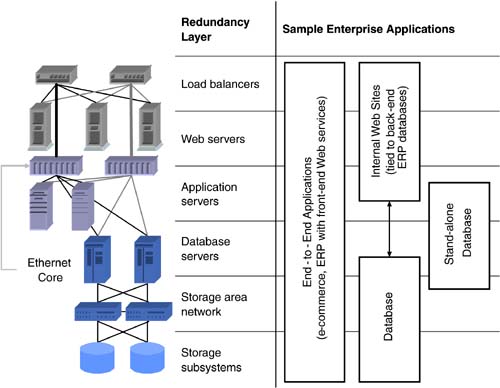6.4 Corporate Systems
| This section discusses availability for a few applications common to most organizations. The discussion and the list serve as examples of a significantly larger applications and solution set. Most business applications today provide connectivity over the Internet and an intranet through a Web interface. The architecture for these applications typically involves one or more of the following layers .
Various enterprise applications fit across redundancy layers for the larger storage infrastructure, as shown in Figure 6-12. Each application has its own specific requirements that merit attention. Figure 6-12. Layers of storage redundancy and sample enterprise applications. 6.4.1 External Web SitesExternal Web sites typically serve static Web pages, which are periodically refreshed with updated content. These Web sites typically include the load balancer layer and the Web server layer. With mostly static content, the availability requirements from a storage perspective are not incredibly strict assuming content can be easily reconstructed through backups . Real-time availability is provided by redundancy across load balancers and Web servers. Storage administrators would be wasting money to deploy real-time replication on Web sites serving mostly static content. 6.4.2 Internal Web SitesInternal Web sites are more frequently tied to back-end applications, such as employee expense report tools tied to ERP systems. In this case, as internal Web applications become more integrated with the enterprise infrastructure, outages affect more people. These applications serve employees rather than customers, and extended outages wouldn't necessarily garner coverage on CNN. A balance needs to be reached between reasonable availability levels without incurring excessive costs. 6.4.3 E-CommerceFor most e-commerce applications, organizations pull out all the stops to guarantee that revenue-generating systems remain online 24/7/365. E-commerce applications typically have the most customer impact. More and more companies, even those not associated with e-commerce, sell products and services via external Web sites. 6.4.4 EmailLoss of email applications can dramatically impact company and employee productivity. However, email is generally an inwardly focused application and may not require the same availability as e-commerce. Legal issues often determine the type and duration of email retention. In the case of law firms, emails may require online access and retention on the order of years . 6.4.5 Enterprise Applications: ERP, CRM, Supply ChainTraditional enterprise applications can easily affect all aspects of a business. Particularly in the case of large-scale business operations where the day-to-day movement of goods and services determines revenue streams, these applications fall into the mission-critical category and may be as important as e-commerce applications are to other businesses. At the same time, some enterprise resource planning (ERP) applications ”such as payroll, which could be easily reprocessed if necessary ”might not require high-availability. If payroll were your core -competency, as is the case with companies like ADP, requirements would be different. 6.4.6 Call CentersCall centers can be optimized for both high availability and optimized deployment using replication and wide-area failover technologies. In the case of customer service centers, databases could "follow the sun" around the globe. This allows the data to be closest to the call centers with the most activity. For example, a major U.S. customer service center may field calls domestically during U.S. business hours. However, at night, it may be more effective to move the call center overseas to India and have midnight calls attended to during Indian daytime business hours. In this case, having the database records in that location facilitates easier queries and request processing. 6.4.7 Making Use of Storage Redundancy LayersStorage systems tailored to specific applications operate across a range of redundancy layers. To optimize storage deployments and availability requirements, storage administrators need to evaluate the architectural dependencies across redundancy layers. Using frameworks provided in this chapter, administrators can apply the right data protection and availability solutions for optimized deployment. |
EAN: 2147483647
Pages: 108
